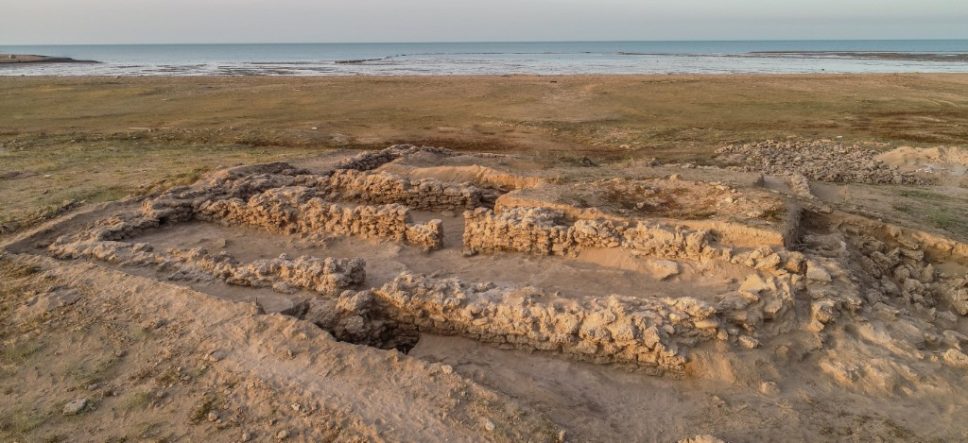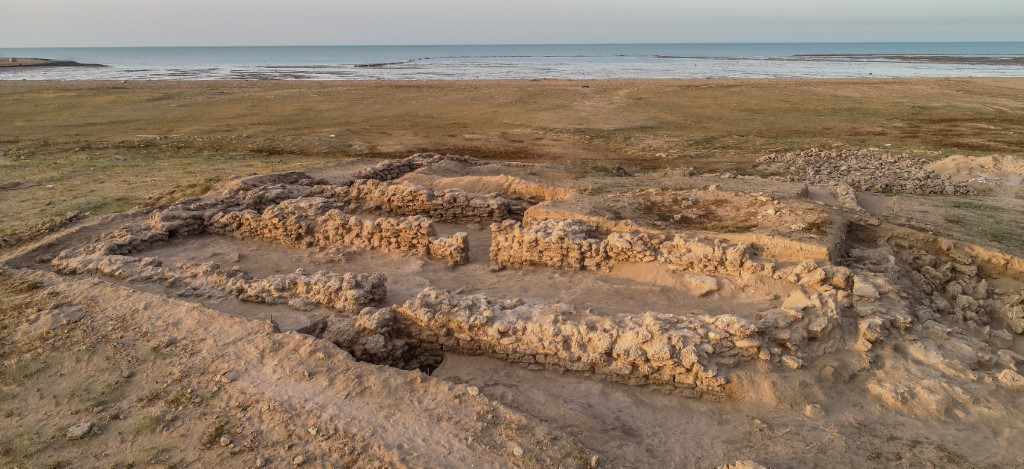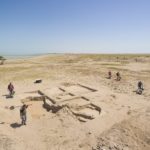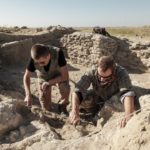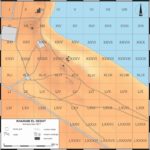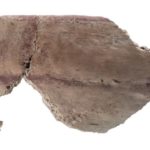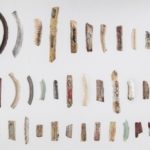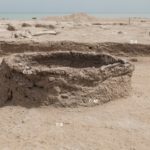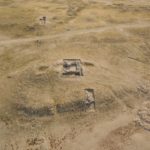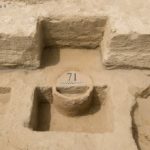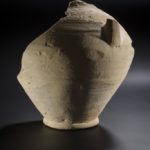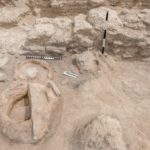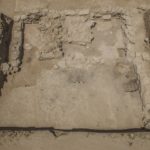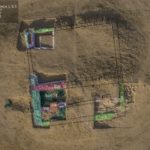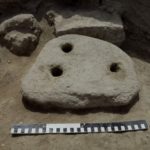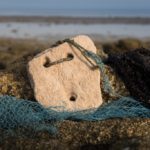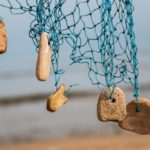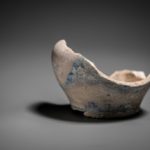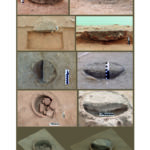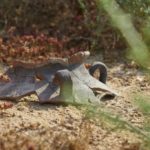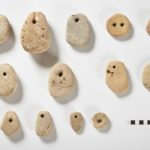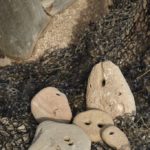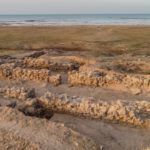Kharāᵓib al-Dasht
Kharaib Desht
Kharaib el‐Desht
Kharaib al-Desht
-
Project name:
Part of the Kuwaiti–Polish Archaeological Mission (KPAM)
Kuwait Failaka Archeological Research Project – comparative study of the settlement patterns on Failaka Island. Investigations of Kharaib el-Desht Settlement Complex
-
Type of site:
Settlement
Location:
Kuwait
Failaka IslandDating:
Late Islamic period (from the end of the 16th to the end of the 19th century)
Most interesting finds:
– Fishing village with domestic architecture and fishing installations (over 100 ovens used for fish processing)
– Large mosque with internal buttresses
– Fishing structures located along the coast of the Kharaib el-Desht Bay
– Rich assemblage of imported glass bracelets
History of research:
Investigated by the PCMA mission in:
2013, 2015–
Type of research:
Excavations, supplemented by underwater research (subproject: M. Nowakowska, MA)
Directors:
Piotr Bieliński – co-director of the Kuwaiti–Polish Archaeological Mission (KPAM)
Hamed Al-Mutairi – co-director of the Kuwaiti–Polish Archaeological Mission (KPAM)
Agnieszka Pieńkowska – project director
Co-operating institutions:
– Polish Centre of Mediterranean Archaeology, University of Warsaw
– National Council of Culture, Arts and Letters of the State of Kuwait
Description of the site and research:
Kharaib el-Desht lies on the north-western coast of Failaka Island. Late Islamic settlement remains cover a stretch of land approximately 450 m long and from 80 to 100 m wide. In written sources, the site is mentioned in connection with the presence of the Portuguese, who are said to have been driven out by a rat infestation sent by Saint Auliya.
The site was first recorded during a survey conducted in 1976 by an Italian archaeological mission. The excavations carried out since 2013 by the Kuwaiti-Polish Archaeological Mission (KPAM) have not only uncovered part of the village but also explored the marine environment of the island.
Traces of settlement uncovered in the eastern part of the site stand directly on bedrock. Judging by the presence of several dozen hearths and ovens, the central part of the hill was reserved for economic activity. In the south-western part of the village, fragments of two houses were discovered. The houses’ inventory included various types of stone anchors, fishhooks, net sinkers and glass bangles; over a hundred fragments of the latter have been found to date.
In the north-eastern part of the settlement, the team found a fragment of a mosque. The building, measuring some 20 x 20 m, was erected on a low escarpment. It consists of a prayer hall and a walled courtyard. The prayer hall is divided by a row of four pillars into two narrow rooms. The entrance to the hall was located in the middle of the north-eastern wall (one of the longer walls) and it led directly to the courtyard. A mihrab niche was situated in the middle of the south-western wall of the building, being the qibla wall. The mihrab was less than a 1 m wide and 1.3 m deep. Next to it, just o.6 m to the north, there was another, smaller niche, that might have once accommodated the mimbar.
The courtyard, measuring 17.5 m by 11.4 m, adjoined the prayer hall on the east. In the northern corner of the courtyard, a stone installation was discovered which enclosed n area of 2 m by approx. 0.8 m. Nearby, immediately under the courtyard wall foundation, the remains of a clay-lined drain were located that served to evacuate water from the courtyard. Probably this was the place for ablutions preceding prayers.
Besides archaeological excavations, underwater research is being conducted along the island’s coast. It has led to the discovery of a few dozen linear and circular stone structures, so-called fish traps. Small clay ovens, very common in Kharaib el-Desht, are also typical of a fishing village. However, their number (over 100) and variety are striking and unparalleled in other late Islamic fishing villages. A significant concentration of these ovens (more than 60) was found in the north-western part of the site where fish processing mainly took place. They were accompanied by few fragments of overfired or sooted pottery as well as a rich bone assemblage, with fish bones predominating. Equipment used for fishing and preliminary fish processing was found both inside the buildings as well as in their direct vicinity. It included, e.g., different kinds of stone anchors, fishing hooks and fishing-net weights made of stone or pottery vessel fragments.
The repertoire of vessels found in the direct vicinity of the fishing installations scarcely differs from the standard furnishings of late Islamic houses. A high percentage of kitchen vessels is, however, noteworthy. The cooking wares included numerous round pots and large straight-walled basins of the Julfar Ware type, as well as handmade, very crude bowls. Various juglets, small bowls, jars and water jugs of the popular ‘Ali Ware/Cream Sandy Ware constituted another major group. The majority of the vessels can be considered tableware, used for serving food. Among them were many kinds of glazed cups and plates with ring bases representing Manganese Purple Underglazed-Painted Ware, Bahla Ware/Khunj Ware, Late Turquoise Glaze Ware, Monochrome Green Glaze and Red-Yellow Ware. The quality of these glazes was rather poor; nevertheless, some vessels showed traces of having been repaired. High-quality imported beakers, plates and decorated porcelain cups (Blue-and-White Porcelain), dating to the 18th century, constituted only a small percentage of pottery finds. Their cheaper imitations made of frit (so-called Blue-and-White Frit) and clay (Blue-and-White Earthenware) were equally rare.
When was the village of Kharaib el-Desht established, who were its inhabitants, what did the fish processing look like and, above all, to whom were its products sold? There are no definite answers as yet. It is, however, certain that fishing was the main economic activity of the villagers who used the favorable geopolitical conditions of the island to make a place for themselves in the contemporary international trade network.
Results of the research:
Season by season – PCMA Newsletter:
Brochure Failaka (2016)
Associated events:
Iwaszczuk U., Pieńkowska A., Wouters W., Gręzak A., Mierzejewska M. (2021). Fishing at the Late Islamic settlement in Kharā’ib al-Dasht, Failaka Island, Kuwait, Archaeological and Anthropological Science, 13, 211 https://doi.org/10.1007/s12520-021-01434-w
Mierzejewska, M. (2021). Evidence for local, regional and interregional exchange networks on Failaka: Some remarks on late Islamic pottery from Kharaib al-Dasht. Arabian Archaeology and Epigraphy, https://doi.org/10.1111/aae.12192
Pieńkowska, A. and Truszkowski, M. (2021). Failaka Island in the Late Islamic Period. Investigations at the fishing village of Kharaib al‐Dasht. Arabian Archaeology and Epigraphy, https://doi.org/10.1111/aae.12189
Lech, P., Zakrzewski, P. (2020). Depopulation and devastation: using GIS for tracing changes in the archaeological landscape of Kharaib al‐Dasht, a Late Islamic fishing village (Kuwait), Archaeological Prospection, 1–8. https://doi.org/10.1002/arp.1790
Mierzejewska, M. (2019). Hearths, ovens and fishery: Kharaib al‐Dasht as a case of Late Islamic fishing village (Jazirat Faylaka), Arabian Archaeology and Epigraphy, 2019; 00: 1–17. https://doi.org/10.1111/aae.12125
Mierzejewska, M. (2019), Islamic harbour in Kharaib al-Dasht Bay? Some remarks on the pottery collection from the Underwater Survey along the coast of Failaka Island, in: Pieńkowska, A., Szeląg, D., Pieńkowska, A. (eds), Stories told around the fountain. Papers offered to Piotr Bieliński on the occasion of his 70th birthday, Warsaw: PCMA, WUW, 479–494.
Mierzejewska, M. (2019). Pottery, fishermen and the Gulf trade. Preliminary Results of Four Seasons of Kuwaiti-Polish Excavations on Failaka Island, Proceedings of the Seminar: Archaeology of Failaka and Kuwaiti Coast – Current Research. Nitra 4–6.10.2016
Pieńkowska, A. (2019). A comparative study of the settlement patterns on Failaka: The Kuwaiti–Polish Archaeological Mission on Failaka Island, 2012–2016, w: Proceedings of the Conference „Archaeology of Failaka and Kuwaiti coast – current research”, Nitra, 159–168.
Pieńkowska, A., Mierzejewska, M. (2018). Late Islamic fishing industry in the Gulf: the case of Kharā`ib al-Dasht, Jazīrat Faylakā, Proceedings of the Seminar for Arabian Studies, 48, 269–278.
Pieńkowska, A. (2017). Failaka Archaeological Research Project. Preliminary results after the second and third season of excavation at Kharaib el-Desht in 2015–2016, Polish Archaeology in the Mediterranean, 26/1, 507–522.
Pieńkowska, A. (2015). Failaka Archeological Research Project – Comparative study of the settlement patterns on Failaka Island. Kharaib Desht 2013, Polish Archaeology in the Mediterranean, 24/1, 560–589.
Appendix 1: Mierzejewska, M., Kharaib El-Desht 2013: The Pottery. Preliminary Report, 571–578.
Appendix 2: Nowakowska, M., Survey of the Kharaib el-Desht Bay on Failaka island: preliminary report, 579–589.
Unpublished reports:
Pieńkowska, A., (Ed.). (2019). Preliminary results of the sixth season of the joint Kuwaiti-Polish excavations at Kharaib Desht (2019) (report for the NCCAL)
Pieńkowska, A., (Ed.). (2018). Preliminary results of the fifth season of the joint Kuwaiti-Polish excavations at Kharaib Desht (2018) (report for the NCCAL)
Pieńkowska, A., (Ed.). (2017). Final Progress Report on Fourth Campaign of Joint Kuwaiti – Polish Archaeological Mission at Kharaib Desht Site on Failaka Island (Kuwait) 19.03–30.04.2017, (report for the NCCAL)
Mierzejewska, M. (2017). Pottery and small finds, Final Progress Report on Fourth Campaign of Joint Kuwaiti – Polish Archaeological Mission at Kharaib Desht Site on Failaka Island (Kuwait) 19.03–30.04.2017, 17–30 (report for the NCCAL)
Pieńkowska, A. (Ed.) (2016). Preliminary Results of the Third Season of the Joint Kuwaiti-Polish Excavations at Kharaib Desht (2016) (report for the NCCAL)
Mierzejewska, M. (2016). Pottery and small finds. In A. Pieńkowska, Preliminary Results of the Third Season of the Joint Kuwaiti-Polish Excavations at Kharaib Desht (2016), 30–44 (report for the NCCAL)
Pieńkowska A. (Ed.) (2015). Kuwaiti – Polish Archaeological Mission in Kuwait Failaka Archeological Research Project – comparative study of the settlement patterns on Failaka Island. Investigations of Kharaib el-Desht Settlement Complex. Final Report (report for the NCCAL)
Pieńkowska A. (Ed.) (2013). Kuwaiti – Polish Archaeological Mission in Kuwait. Archeological Research Project – comparative study of the settlement patterns on Failaka Island. Final Progress Report Season 2013 (report for the NCCAL
Wideo:
Gallery:
-
1. Exploration of an oven; Eksploracja piecyka (fot. A. Oleksiak)
-
2. Widok ogólny stanowiska na kwadrat XII (fot. A. Oleksiak)
-
3. Cleaning of walls; Czyszczenie murów (fot. A. Oleksiak)
-
4. Plan of the site; Plan stanowiska (P. Zakrzewski)
-
5. Fragment of a handmade basin with painted decoration; Fragment ręcznie lepionej misy z dekoracją malowaną (fot. A. Oleksiak)
-
6. Set of glass bracelets; Zestaw szklanych bransoletek (fot. A. Oleksiak)
-
7. Oven; Piecyk (fot. A. Oleksiak)
-
8. 3D model of an oven; Piecyk- model 3D (K. Ochnio)
-
9. Aerial view of Squares XXXIV and XXXV; Widok ogólny na Sq XXXIV i XXXV, zdjęcie lotnicze (fot. A. Oleksiak, obróbka M. Truszkowski)
-
10. Oven (context 71) after exploration, side view; Piecyk (context 71), po eksploracji, widok z boku (fot. J. Stępnik)
-
11. Oven (context 71), top view; Piecyk (context 71) widok z góry (fot. J. Stępnik)
-
12. General plan of rooms discovered in 2016 in Square XII; Plan ogólny pomieszczeń odkrytych w 2016 w kwadracie XII (fot. A. Oleksiak, obróbka Ł. Miechowicz)
-
13. Fragment of a water jug; Fragment dzbana na wodę (fot. A. Oleksiak)
-
14. Ovens uncovered in the courtyard in Square XXXIV-I-10; Konstrukcje piecyków znalezione na dziedzińcu w kwadracie XXXIV-I-10 (fot. J. K. Witkowski)
-
15. Locus 3 and the concentration of ovens in the adjacent courtyard, top view; Locus 3 i koncentracja piecyków na przylegającym dziedzińcu, widok z góry (fot. M. Truszkowski)
-
16. Aerial view of the building in Squares XXIV and XXXV; Zdjęcie lotnicze – widok ogólny – budowla w kwadratach XXIV i XXXV (fot. M. Truszkowski)
-
17. Three-holed stone anchor found in situ; Kotwica kamienna 3-otworowa – znaleziona in situ (fot. J. Stępnik)
-
18. Three-holed stone anchor; Kotwica kamienna 3-otworowa (fot. J. K. Witkowski)
-
19. Three-holed stone anchor; Kotwica kamienna 3-otworowa (fot. J. K. Witkowski)
-
20. Fishing-net weights; Obciążniki do sieci rybackich (fot. J. K. Witkowski)
-
21. Fragment of a Blue-and-White Frit cup; Fragment czarki typu Blue&White frit ware (fot. J. K. Witkowski)
-
22. Various kinds of ovens found in Squares III-C-6/III-C-7/III-D-6/III-D-7; Zestaw różnych rodzajów piecyków znalezionych w kwadratach III-C-6/III-C-7/III-D-6/III-D-7 (fot. A. Oleksiak, obróbka P. Zakrzewski)
-
23. Fragment of a kitchen vessel; Fragment naczynia kuchennego (fot. A. Oleksiak)
-
24. Stone and clay fishing-net weights; Zestaw kamiennych i glinianych obciążników do sieci rybackich (fot. A. Oleksiak)
-
25. Fishing-net weights; Obciążniki do sieci rybackich (fot. A. Oleksiak)
-
26. Remains of a mosque / Pozostałości meczetu (Fot. S. Lenarczyk)

